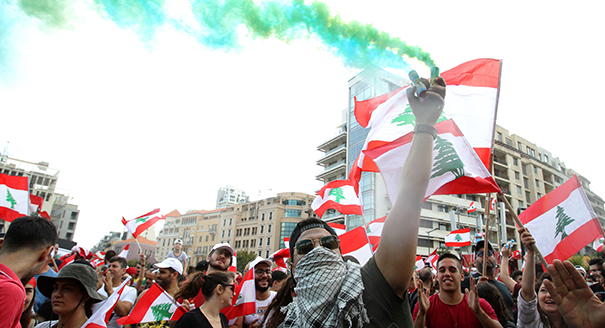What Happened?
Massive protests erupted last Thursday after the government announced two new regressive tax measures—a 20 cent daily fee on internet phone calls, including those on the much used WhatsApp application, and a plan to increase the value-added tax from 11 percent to 15 percent by 2022. These were to be added to a long list of austerity measures adopted by the government last year to deal with Lebanon’s current economic and financial crisis. The fee for internet calls was later revoked, but this did little to contain the nationwide demonstrations that had broken out.
Lebanon has the third highest level of public debt in the world—equivalent to 150 percent of GDP—and is in deep recession. Poverty and unemployment rates are high, with a third of those under the age of 35 being unemployed. Inequality levels are extreme and the state does not provide adequate public services, while infrastructure is crumbling. Given these dire circumstances, introducing austerity measures to address the debt is particularly inappropriate. This has impoverished a larger share of the population, leading to growing resentment as the richest (among them members of the ruling elite) were not asked to participate in alleviating the debt. Their profits and wealth were not taxed and the means by which they extracted rents from the banking and real estate sectors were left intact. The “WhatsApp tax” was the straw that broke the camel’s back.
Why Does It Matter?
The protests are important for several reasons. They are the largest since the demonstrations that took place in 2005 after the assassination of the late prime minister Rafiq al-Hariri. Second, they have been spontaneous, not directed by political parties or leaders. Third, they have spread all over Lebanon and are not only limited to Beirut or the country’s main cities. Fourth, they are not sectarian: The protestors have criticized political leaders from their own communities, which is unprecedented.
How might sect-based cleavages, which are vital in Lebanon’s political life, be overcome? A large share of the Lebanese population is now unified in economic and social distress, quite independently from their sectarian origins. The austerity measures have contributed to a generalized fatigue with the way the government has mismanaged the country in recent years. They have also exacerbated inequalities, making the disconnect between the political class and the rest of the population even more salient.
To share one figure: The richest 0.1 percent of the population—around 3,000 individuals, among them a large part of the political class—earns 10 percent of total national income, which is what the bottom 50 percent of the population earns. This gap is probably a main driver of the unity observed in the streets since Thursday. Class or socioeconomic claims have transcended sect-based cleavages.
What Are the Implications for the Future?
These protests appear to mark a turning point in recent Lebanese history and make us wonder whether Lebanon will manage to break the political and economic deadlock in which it has been stuck since the end of the civil war in 1990.
So far, the government’s answer to the people’s demand for resignation has been limited: Few ministers have resigned and Prime Minister Saad Hariri has proposed a 50 percent cut in the salaries of senior civil servants, parliamentarians, and politicians, as well as the removal of some of their privileges. He has also proposed to speed up the construction of new electrical power plants and impose a tax on banks’ profits to raise the equivalent of $3.38 billion. If these measures go in the right direction, they are unlikely to earn him public trust or end the protests. In a way they highlight the government’s hypocrisy even more, as it was able to suddenly find billions of dollars in a very short timeframe when it had failed to do such a thing previously, opting instead to raise taxes.
With regard to political changes, the resignation of the government and the formation of a transitory government that holds new elections and implements drastic reforms are a possible scenario. Yet it is still unclear who would belong to such a government and what specific steps would be taken for a political transition. Technocrats or civil society representatives, as well as members of independent parties in previous elections, are likely to receive popular support.
Regarding economic changes, the state’s mismanagement has allowed a wide margin for measures and reforms that could ease the situation and raise revenues, even within the current budget. These could include a partial cancellation of the debt held by domestic banks and a reduction in the interest rates on previous debt, as well as compelling banks to loan to the state at zero percent interest for one to three years; introducing a progressive income tax as well as a capital gains tax; and investing heavily in infrastructure.












